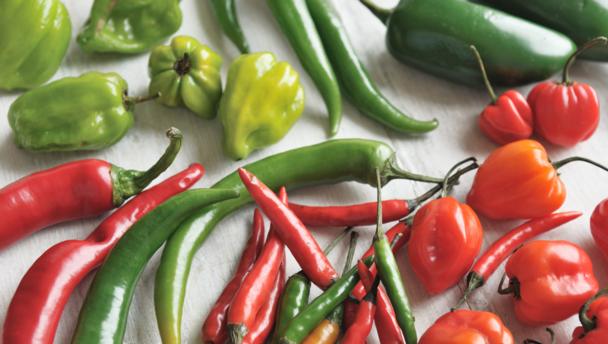 History
History
- Chili was first cultivated by the people of Central and South America in around 3000BC.
- Columbus brought seeds back to Europe in 1493, and from there it has spread to the cuisines of the entire world.
Climate
- warm and humid climate for growth and dry weather during maturity.
- Tropical and sub-tropical regions but it can withstand heat and moderate cold.
- It can be grown over a wide range of altitudes from sea level up to nearly 2,100 meters.
- Heavy rainfall leads to rotting of the crop. Unfavorable temperatures lead to bud blossom and fruit drops.
Soil Type
- Light sands to well drained clay
- Silty and clay loam soils are better, while water-logged and alkali is not suitable.
Nursery
- Well prepared one meter wide and three meters long strips prepared
- Straws or farm yard manure is burned on the strips after which seeds are broadcast and pressed in the soil and covered with a thin layer of soil. These are then covered with layers of straws supported by wooden sticks with water application in the morning and evening till the seeds germinate
- After six weeks seedlings become ready for transplanting
Soil Preparation
- Two ploughing with mould board plow
- 1 bag of saver at time of sowing
- After land preparation, ridges of one and half foot high and wide are prepared.
Transplanting
- Transplant on both sides of the ridges avoid overlapping
- Plant to plant distance one and a half foot
- Transplant is carried out in evening
Irrigation
- After transplantation two irrigations applied
- Subsequent irrigation is applied as per climatic conditions
Varieties
Ghotki
Grown in Ghotki, Khairpur, Shikarpur and Kotri in February and March
Longi
Grown in Mirpurkhas, Nawabshah, Sanghar and Tharparkar districts. Nursery of this variety is raised in January, February
Talhar (late variety )
Grown in Badin, Thalhar and Tando Muhammad Khan Hyderabad. Nursery is raised in June, July
Sanam
Mostly grown in Karachi division, but successfully grown in Mirpurkhas and Hyderabad districts, also. Both in winter and summer.
Fertilization
- 1 bag of DAP
- 1 bag Potassium Sulphate before sowing
- 2-3 bags of urea
- 1 bag 20 days of transplanting
- 1bag at flowering stage
- 1bag if necessary, at fruit setting
Boron deficiency in Chilies

The growing points die and decay and the leaves are misshapen.
Intercultural Practices
- 3-4 interculturings
- First interculturing within one month after transplanting.
At flowering stage
Earthling up is recommended, helps in growth and development of the crop. It prevents the crop from lodging.
Diseases
- Rot and die back
- Bacterial wilt
Control
- Careful seed selection
- Early removal of affected plants
- Seed treatment with vitavax
- Disease tolerant varieties
Pests
Aphids: (greenfly and blackfly)
spraying with dimethoate, derris or malathion. If the chillis are ready for picking use derris.
Red spider mite
Common pest in the greenhouse in hot dry conditions, causing leaf discoloration and affecting growing adversely.
Spraying weekly with dimethoate and malathion can control the problem as well as creating a damp atmosphere.
Whitefly
Causing a black deposit of sooty mould on the leaves.
3 to 4 sprays of pyrethum, permetmrin or pirimiphos-methyl every week.








Sir g how many irrigation required for green Upto harvesting
Sir! Seed rate r sowing time bhe mention kar dain kindly.